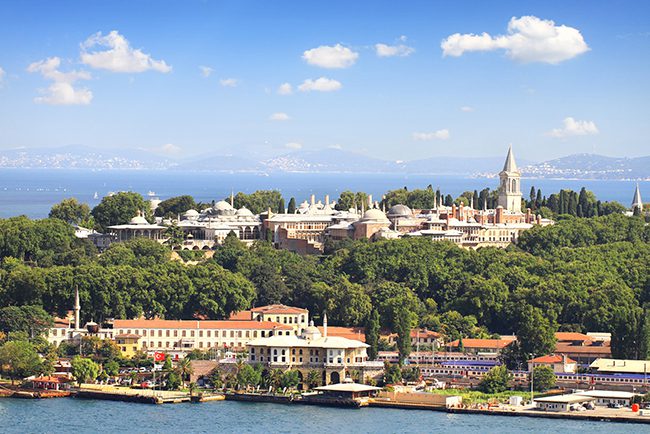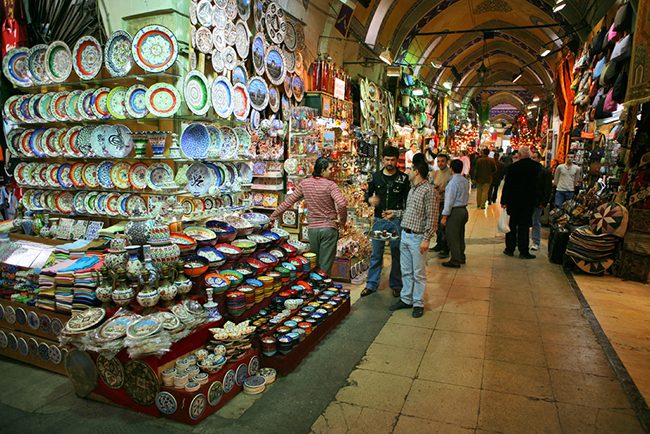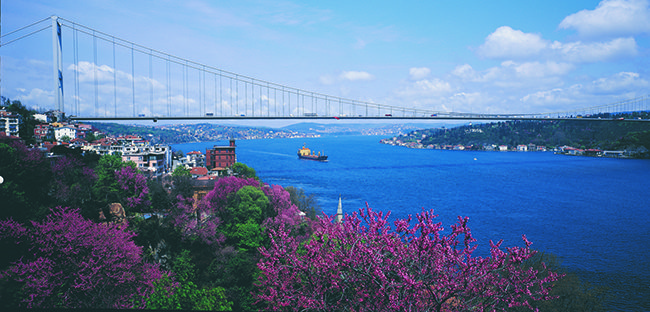Poised at the meeting point of Asia and Europe on the old Silk Road, it’s bustling, exotic, glistening with places and mosques, sparkling fountains, leafy squares and breezy waterways.
[vc_row][vc_column width=”1/4″][vc_separator color=”black” border_width=”10″][vc_custom_heading text=”Asia”][vc_separator color=”black” border_width=”2″][vc_widget_sidebar sidebar_id=”sidebar-page”][/vc_column][vc_column width=”3/4″][vc_column_text]
Legendary City on Bosphorus
View across Istanbul, with Galata Bridge and Golden Horn Harbor straight ahead
Poised at the meeting point of Asia and Europe on the old Silk Road, it’s bustling, exotic, glistening with places and mosques, sparkling fountains, leafy squares and breezy waterways. The legendary Bosphorus flows right through the city, linking the Black Sea to the Sea of Marmara and the Mediterranean and marking the boundary between East and West. The western side is further divided by the lovely inlet of the golden Horn heading down to the tip of the peninsula and its treasure trove of culture highlights. Named Byzantium in Greek times, then Constantinople later Istanbul, the city prospered during the Byzantine (Eastern Roman) and Ottoman empires, the perfect capital in such a privileged location, with a brief interlude of Venetian rule in the 13th century.
All left colorful legacy but for many visitors, the top attraction remains the Topkapi Place, built by sultan Mehmed ll who established Ottoman rule in 1453. Perched on a promontory above the confluence of the Bosphorus and Golden Horn, looking towards the open sea to the south, it offers one of the most glorious panoramas in Istanbul. But before enjoying the view from the imperial terrace, there are four compounds to explore in a never ending maze of archways and colonnades, pavilions and halls displaying silk fabrics, manuscripts, portraits, holy relics, Iznik tiles, mosaics and much more. The dazzling Imperial Treasure includes the 86 carat Spoonmaker’s Diamond and the Topkapi Dagger studded with emeralds and diamonds.

Istanbul
Legendary City on Bosphorus
Topkapi Palace built by Sultan Mehmad II
After such overwhelming opulence, the Blue Mosque feels like a breath of fresh air with its vast arcaded courtyard and cascading domes topped by slender minarets above the shores of Marmara. Even the sultan had to bow his head to pass through the gate and inside, the lofty prayer hall oozes peace and simplicity, flooded in natural light. Only the marble mihrab and elaborate pulpit add a touch of grandeur to the ancient calligraphy on pillars and domes.
Worshippers prostrate on donated carpets while the sun filters through 260 stained glass windows, lighting up some of the 20,000 blue tiles which give the mosque its name. Colours have faded over time but one can only wonder at the young enlightened Sultan Ahmed who presided over the foundation ceremony in 1609, digging the earth with a velvet-handled tool until he was exhausted. Unlike the Palace, entrance is free but the mosque is closed to non-worshippers during daily prayers.
The Blue Mosque stands on the edge of Sultanahmet Square, once a Roman Hippodrome holding up to 100,000 spectators who gathered to watch the games as silken banners fluttered around the imperial Loggia. Wild beasts and chariots have long gone but today the square is graced by a pretty gazebo-style fountain and obelisks and columns rising through the greenery. Most unusual is the Serpentine Column, depicting three intertwined but headless snakes, brought from Greece by Constantine the Great.

Istanbul
Legendary City on Bosphorus
Interior of Hagia Sophia,Shops at Grand Bazaar, Colourful Lanterns, Hand Painted Ceramic.
At the other end of the square, Hagia Sophia is easily recognized by its red wall and minarets. Restored and converted into a mosque by Mehmet the Conqueror, it had been the world’s largest cathedral for 1000 years , a monumental feat at the time of construction, now a dark cavernous museum where Byzantine mosaics mingle with Koranic verses.
Near the city walls to the north – west , the Chora Monastery went through a similar fate but the finely restored mosaics and frescoes are well worth a detour and the smaller setting, though busy at times, is truly inspiring. A few steps away, traditional Ottoman houses cling to the hillside with upper floors overhanging the lanes and windows draped in wrought iron grilles. Potted plants enhance the facades painted mint green, deep red, sky blue or creamy white, visitors sip fresh orange juice under the trees and on the edge of the square, souvenir sellers wait for the afternoon siesta.
But there’s no time for siesta in the Grand Bazaar where over 4,000 shops jostle cheeks by jowl in a grid of 60 streets or so. Rebuilt and extended several times since the 15th century, this is one of the world’s largest covered markets , a dizzying kaleidoscope of colours, sounds and smells shared by over 200,000 visitors a day. Its defies imagination but within a few moments, you are caught under the spell, wandering from lane to lane, marveling at hand-painted ceramics, silver and gold, carpets, textiles, leather and multi-coloured lanterns brushing your hair as you go past. The air smells of spice and apple tea, water pipes bubble and locals and visitors bargain for amber beads, gilded icons, copperware, embroidered slippers, leather, antiques, carpets or mother of pearl. This is a city within a city with its own marble fountains, cafes, hammam and mosques. The Bazaar is open every day except Sunday and Bank Holidays, from 9 am to 7.00pm.
Shopping over, it’s good to stroll through the streets where more wonders, large and small, await on every corner. Here’s Suleymaniye, another magnificent mosque,’as high as a feather’, there a statue of Ataturk, founder of the Republic, the shrine of a holy man, the remains of a Roman aqueduct and more museums than you could see in a week. There are tea gardens and secluded squares and parks where roses and tulips bloom along meandering paths. A cool promenade lines the eastern shore of the peninsula, offering glimpses of the Blue Mosque, the Topkapi Place and on a clear day, the idyllic Princes’ islands on the horizon.

Istanbul
Legendary City on Bosphorus
the Bosphorus is full of simple delights,gardens festooned in magnolia and oleander, humble mosques, waterside villas in pastel colours
But the ultimate treat in Istanbul is sailing on the Bosphorus, gazing at myriad historical building on both sides of the strait. Cool sea breezes and verdant hills, this beautiful place was a magnet for sultans and pashas and when the channel was fully secured, palaces and pavilions popped up all around.
Favourites include Aynali Kavak, adorned in Venetian mirrors, Beylerbeyi on the Asia side where sultans hosted their guests and perhaps the most glorious of all, dolmabahce, an intriguing blend of Ottoman and Western décor and principal residence of the sultans from 1856 onwards. But beyond the glamour, the Bosphorus is full of simple delights, gardens festooned in magnolia and oleander, humble mosques, waterside villas in pastel colours, now a Venetian scene, now an Arabian dream or a 21st century call as an ocean liner approaches the suspension bridge stretching for 1.5 km across the strait.
Cargo vessels, galleons, luxury yachts, fishing boats, ferries, it’s a busy channel yet totally enchanting. The old fortress still guards the narrowest point while scenic bays and seafood restaurants beckon along the shores. Regular ferries and tourist boats offer a variety of trips from the eminonu docks.
For the people of Istanbul, Eminonu is the heart and soul of the city, ferry boats, anglers, street vendors, the double – decked Galata bridge spanning the Golden Horn, the iconic tower with splendid views over Bosphorus, the floating kitchens bobbing near the shore, garlanded in light as dusk falls over a skyline bristling with minarets and domes. In 1923, the capital was moved to Ankara but the magic did not fade:’The best thing about Ankaar,’ said a Turkish poet, ‘is the way back to Istanbul’.
Subscribe to the latest edition now by clicking here.
If you would like to comment on this story or anything else you have seen on World Travel Magazine, head over to our Facebook page or message us on Twitter.
And if you liked this story, subscribe to our bi-monthly World Travel Magazine, a handpicked selection of editorial features and stories from Global Destinations, Inspire Me, Insider, Style File, Wellness & Travel, City Travel, Suite Life, At Leisure, Short Breaks and much more.
[/vc_column_text][/vc_column][/vc_row]



